Road–rail vehicle
A road–rail vehicle is a dual-mode vehicle which can operate both on rail tracks and a conventional road. They are also called hi-rail, from highway and railway, or variations such as high-rail, HiRail, Hy-rail, etc.
They are often converted road vehicles, keeping their normal wheels with rubber tires, but fitted with additional flanged steel wheels for running on rails. Propulsion is typically through the conventional tires, the flanged wheels being free-rolling; the rail wheels are raised and lowered as needed. Purpose-built road–rail vehicles also exist.
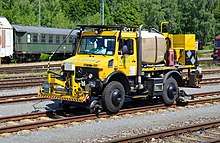
Overview
Such vehicles are normally used for railroad right-of-way maintenance during engineering possessions of the line. They can be driven on roads to near the site and then converted to a rail vehicle for the final journey to the worksite. This avoids the complex maneuvers that would be associated with a road vehicle accessing a worksite that is not near a road. Since they are normally converted road vehicles, they would not fare well in a collision with heavy rolling stock and therefore can normally only drive on rail tracks under an engineering possession (the line is closed to normal traffic). They are generally designed to be insulated, thus they do not activate track (signaling) circuits, although some rail operators, normally those operating remote lines without boom gates, etc., prefer them to be non-insulated so that they are detectable by train safety systems.
Road–rail buses
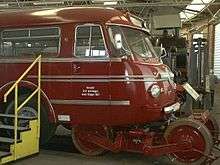
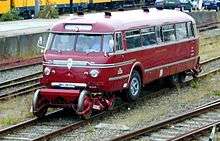

.
Attempts have been made over the years to design buses and coaches that could operate on both roads and railway tracks. These attempts were never particularly successful. Some were carried out in Britain during the 1930s, on the Nickey Line by LMS, using a Ro-Railer. In Australia, the New South Wales Government Railways tried road–rail vehicles during the 1970s on New South Wales routes.
The Deutsche Bundesbahn operated buses, called the Schi-Stra-Bus, that could be fitted with separate bogies in different areas from the 1950s to 1970s.
Road-transferable locomotive
The RTL is a semi truck with railway wheels that can be lowered when operating on the railway tracks. It was pioneered by in the early 1990s by Australian National and later refined in Victoria. The idea was to have a locomotive that could transfer from one branch line carrying mainly wheat to another parallel branch line, where the rail connection is very roundabout. The RTL suffered a number of disadvantages. Loads were severely limited when the track was steeply graded. The rubber traction wheels slipped on the steel rails when wet. The life of the rubber tires was rather short.
The Canadian company Brandt has also converted large truck tractor units for use as locomotives that can move by road to where they are needed. Still mostly used for permanent way maintenance, they can also be employed as thunderbird (rescue) locomotives or even used in normal service, where they are suitable for smaller operators.
In East Germany some Fortschritt ZT 300 tractors were used in road–rail service.
Shunting
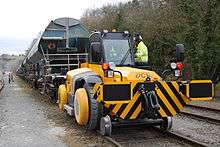
Road–rail vehicles are also serve as motive power for shunting, the process of sorting items of rolling stock into complete trains, or the reverse.
In Belgium, the company UCA produces the UCA-TRAC, road–rail vehicles based on the chassis of a JCB Load-All (UCA-TRAC B) and JCB Fastrac (UCA-TRAC F). The UCA-TRAC provides traction through its rubber wheels and is designed to act as a rail car mover.
In Australia, similar vehicles are built by Aries Rail using Volvo loaders and AUSA telehandlers. These vehicles are able to be used for other purposes such as shovelling or forklifting whilst not operating on-rail.
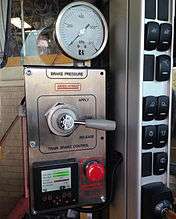
Such vehicles often have cabin-mounted controls for the railway air brake system so that the driver can apply and release the train brakes during shunting manoeuvres. In order to charge the train brake air hose, an air compressor needs to be fitted to the road–rail vehicle.
Maintenance
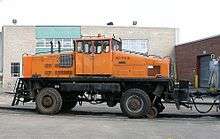
Rolling stock maintenance
Self-propelled maintenance vehicles for maintenance of the track and for shunting wagons are much more convenient to use if they can transfer to the road to reposition or otherwise get out of the way. Because relatively light loads are involved, the problems plaguing the Road Transferable Locomotive are avoided.
An example would be a forklift truck fitted with railway wheels and a coupling with which to shunt a wagon or two.
In Belgium, the company UCA bvba has been constructing road–rail vehicles since 1981. UCA started with converting WF-trac and MB-trac for rail traction uses. They built rail car movers, shunting locotractors and other road–rail vehicles. Best known is the UCA-TRAC, based on the chassis of a JCB Load-All (UCA-TRAC B) and Fastrac (UCA-TRAC F). The UCA-TRAC provides traction through its rubber wheels.
Safety issues
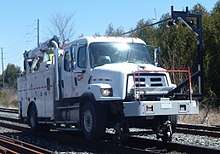
Road–rail vehicles, particularly those used for inspection purposes, have been involved in a number of serious incidents, including deaths. There has been ongoing discussion regarding maintenance and inspection standards, including load and load distribution, to minimise the risk of failures.
Factors leading to derailment include failed locking equipment, wheel failure, damaged rail wheel support systems, inappropriate tires, and uneven or overloading issues.
In Australia, the Rail Industry Safety and Standards Board (RISSB) is working with manufacturers and operators to produce an Australian standard to which road–rail vehicles must comply.
When operating in road-going mode, drivers have to remember that the dynamics of the vehicle will be changed due to the increased weight at the front and rear of the chassis. Some manufacturers have developed systems that allow the rail wheels to be stored almost entirely inside the original bodywork[1] thus moving the centre of mass closer to the road axles. This greatly improves the on-road driving performance of the vehicle.
Makes
Evans Auto-Railer was a pioneer in the US in the 1930s and 1940s.[2] Evans seems to have produced all road–rail vehicle adaptations for the U.S. military during WWII, but was rapidly overtaken by Fairmont immediately post-war.
Aries Hyrail branded vehicles have been manufactured in Australia for several decades. Aries Hyrail vehicles continue to be manufactured by Aries Rail.
Continental Railworks is a road-rail conversion unit manufacturer based in Montreal, Canada, producing hi-rail units since 1997. Their products are known for the automatic locking / unlocking feature and for the rubber spring induced downforce applied to the rails.
Gallery
 Unimog 405/UGN road-rail vehicle used as a rail car mover
Unimog 405/UGN road-rail vehicle used as a rail car mover A Ford Ranger on the Puffing Billy Railway, a self-propelled vehicle that can be legally used on both roads and rails
A Ford Ranger on the Puffing Billy Railway, a self-propelled vehicle that can be legally used on both roads and rails The Cahaba Material Handler. This vehicle is mainly used for hauling cross-ties and scrap metal for on-rail application. It is equipped with an electromagnet that assists in scrap and debris cleanup.
The Cahaba Material Handler. This vehicle is mainly used for hauling cross-ties and scrap metal for on-rail application. It is equipped with an electromagnet that assists in scrap and debris cleanup.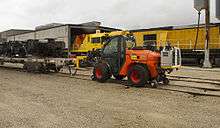 A USA telehandler fitted with train coupler and train brake system
A USA telehandler fitted with train coupler and train brake system Japanese road-rail bus
Japanese road-rail bus
See also
| Wikimedia Commons has media related to Road-rail vehicles. |
- Alden staRRcar
- Cater MetroTrolley
- Dual mode transit
- Maintenance of way
- Nicky Line – Where some test of a road-railer bus were carried out in the 1930s
- Railcar
- Railcar mover
- Railroad speeder
- Railway Mokes
- Roadrailer, a kind of semi-trailer
- Unimog
- Wheelset
Notes
- "Aries Rail LinkedIn page". Aries Rail. Retrieved 14 December 2014.
- "Chevrolet Leader News (Vol. 1, No. 2) : Handy (Jam) Organization : Free Download & Streaming : Internet Archive". Archive.org. Retrieved 2014-07-23.